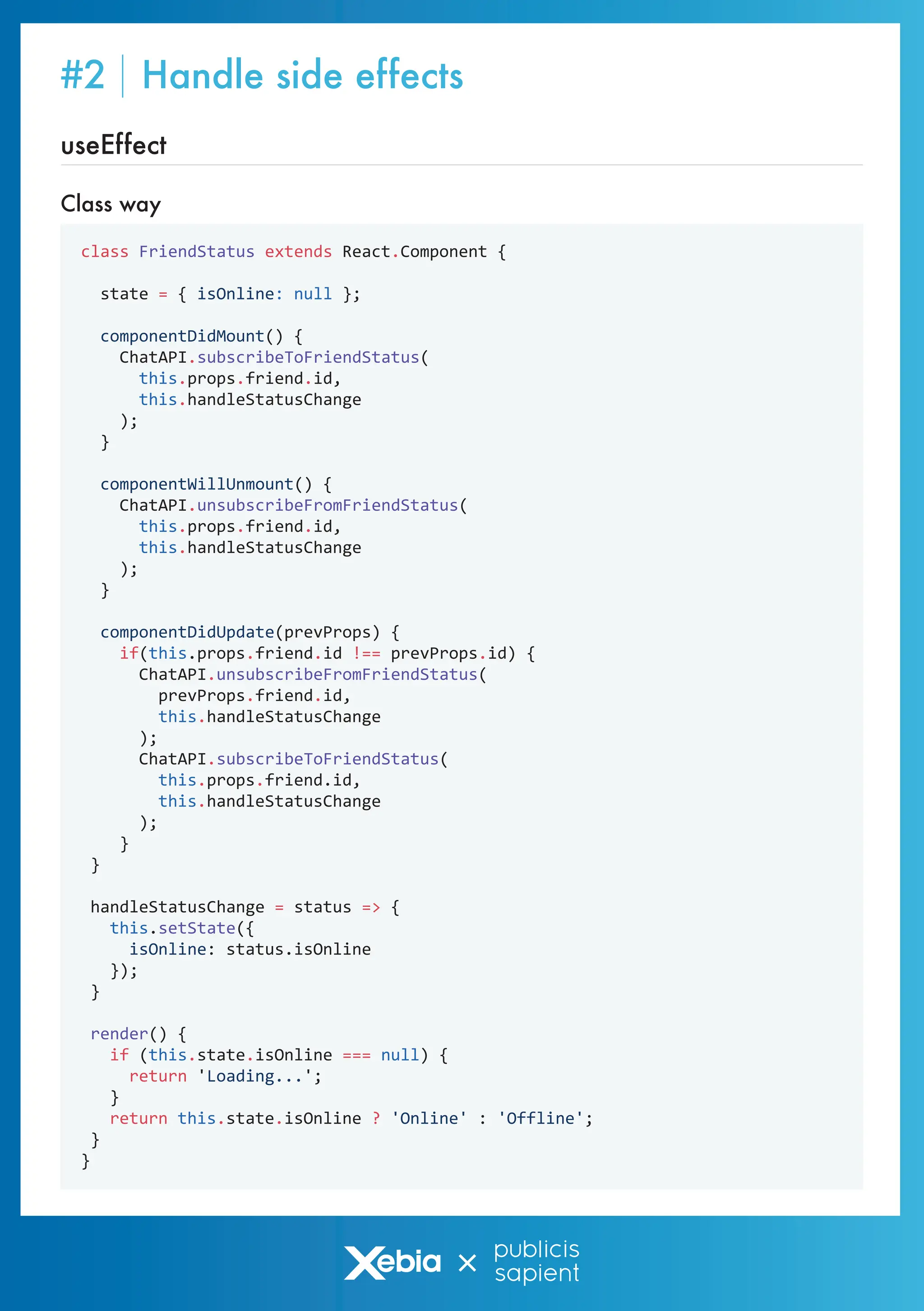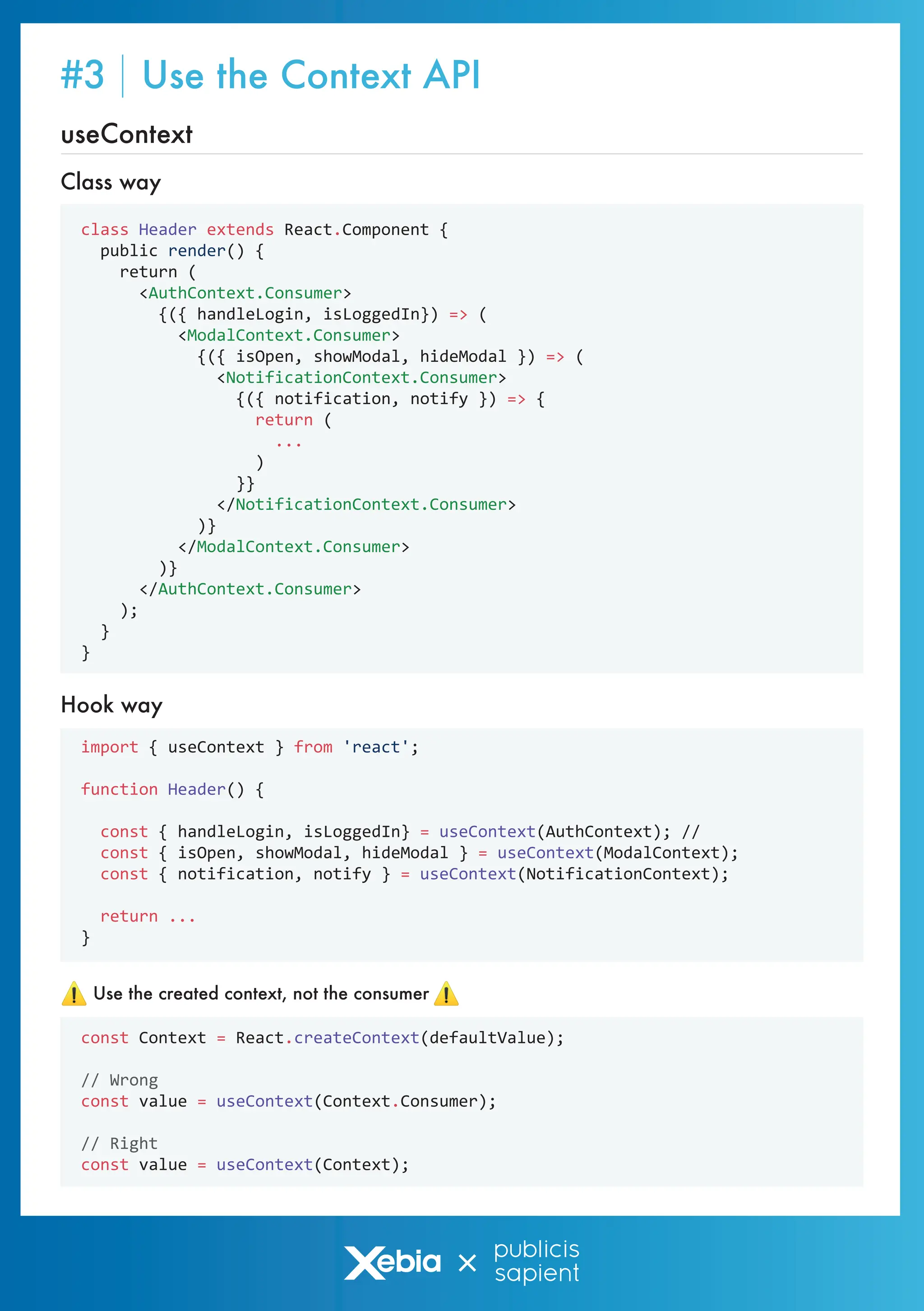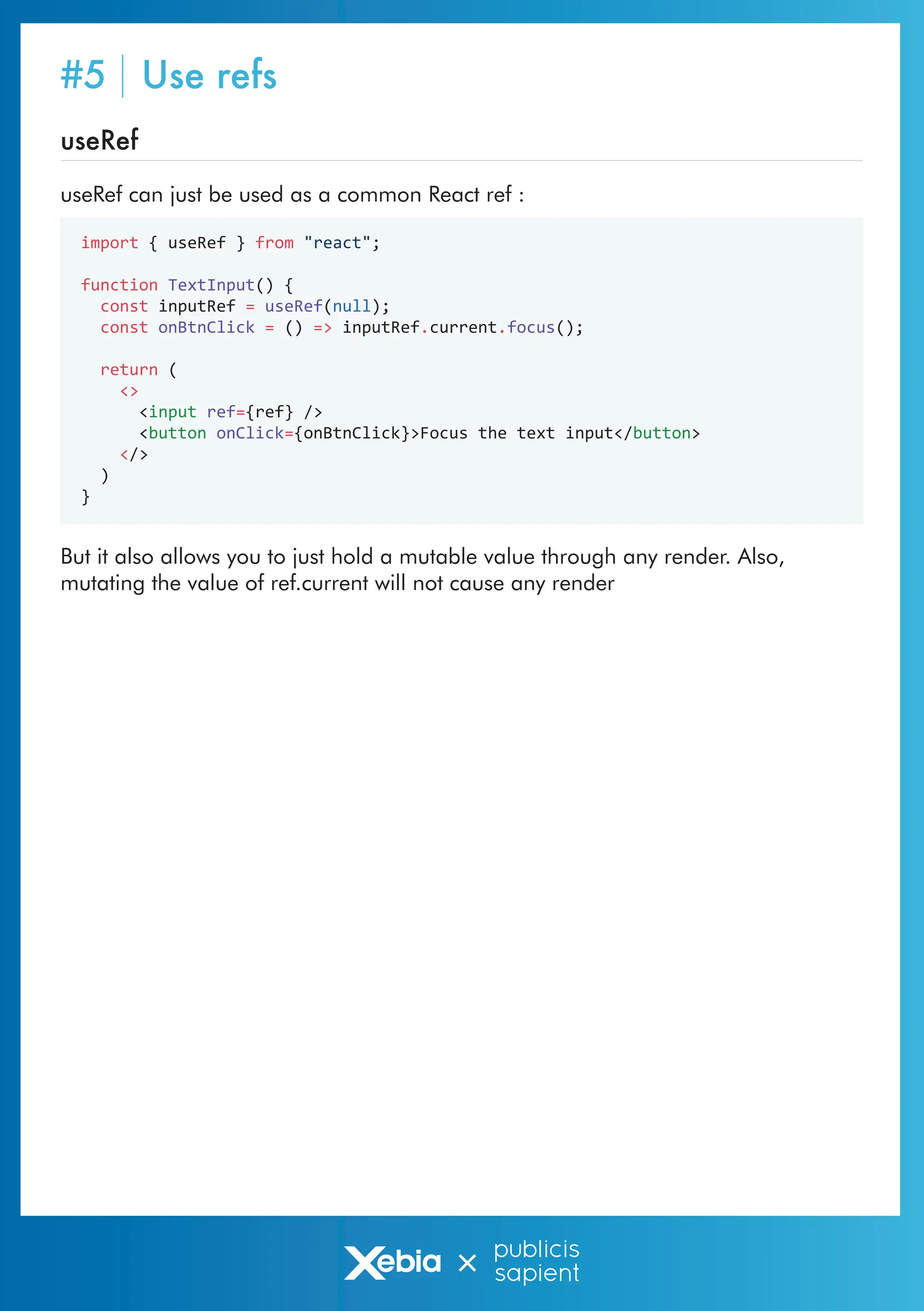1. React Hooks allow you to use state and other React features without writing a class. Key Hooks include useState, useEffect, useContext, useReducer, useCallback, and useRef.
2. useState is used to add state to function components. useEffect is used to perform side effects from a function component. useContext provides access to data from React's Context API.
3. Other Hooks like useCallback and useMemo optimize performance by memoizing functions and values. useRef provides a way to access DOM nodes and attributes from function components. Custom Hooks allow extracting reusable logic.

![SUMMARY
Manage state
useState
const [count, setCount] = useState(initialCount);
useReducer
const [state, dispatch] = useReducer(
reducer,
initialState,
initialDispatch
);
useEffect
useEffect(() => {
applyEffect(dependencies);
return () => cleanupEffect();
}, [dependencies]);
useLayoutEffect
useLayoutEffect(() => {
applyBlockingEffect(dependencies);
return cleanupEffect();
}, [dependencies]);
Use the Context API
useContext
const ThemeContext = React.createContext();
const contextValue = useContext(ThemeContext);
#1
Handle side effects
#2
#3](https://image.slidesharecdn.com/reactjshookssheet-231118172030-d4f2541e/75/React-JS-Hooks-Sheet-pdf-2-2048.jpg)
![Memoize everything
useMemo
const memoizedValue = useMemo(
() => expensiveFn(dependencies),
[dependencies]
);
useCallback
const memoizedCallback = useCallback(
expensiveFn(dependencies),
[dependencies]
);
Use refs
useRef
const ref = useRef();
useImperativeHandle
useImperativeHandle(
ref,
createHandle,
[dependencies]
)
Reusability
Extract reusable behaviour into custom hooks
#4
#5
#6](https://image.slidesharecdn.com/reactjshookssheet-231118172030-d4f2541e/75/React-JS-Hooks-Sheet-pdf-3-2048.jpg)
![#1 Manage state
const initialCount = 0;
class Counter extends Component {
constructor(props) {
super(props);
this.state = { count: initialCount };
}
render() {
return (
<div>
<p>You clicked {this.state.count} times</p>
<button
onClick={() => this.setState(({count}) => ({ count: count + 1 }))}
>
Click me
</button>
</div>
);
}
}
import { useState } from "react";
const initialCount = 0;
function Counter() {
const [count, setCount] = useState(initialCount);
return (
<div>
<p>You clicked {count} times</p>
<button
onClick={() => setCount((c) => c + 1)}
>
Click me
</button>
</div>
);
}
Hook way
useState
Class way](https://image.slidesharecdn.com/reactjshookssheet-231118172030-d4f2541e/75/React-JS-Hooks-Sheet-pdf-4-2048.jpg)
![useReducer
const initialState = {count: 0};
function reducer(state, action) {
switch (action.type) {
case 'increment':
return {count: state.count + 1};
case 'decrement':
return {count: state.count - 1};
default:
throw new Error();
}
}
function Counter({initialState}) {
const [state, dispatch] = useReducer(reducer, initialState);
return (
<>
Count: {state.count}
<button onClick={() => dispatch({type: 'increment'})}>+</button>
<button onClick={() => dispatch({type: 'decrement'})}>+</button>
</>
);
}
An alternative to useState. Use it in the components that need complex state
management, such as multiple state values being updated by multiple methods
#1 Manage state](https://image.slidesharecdn.com/reactjshookssheet-231118172030-d4f2541e/75/React-JS-Hooks-Sheet-pdf-5-2048.jpg)

![Class way
Hooks way
import { useState, useEffect } from 'react';
function FriendStatus(props) {
const [isOnline, setIsOnline] = useState(null); // Store friend's online
status
const handleStatusChange = (status) => setIsOnline(status.isOnline); // Set
up a status change handler
useEffect(
() => {
// Update status when the listener triggers
ChatAPI.subscribeToFriendStatus(
props.friend.id,
handleStatusChange
);
// Stop listening to status changes every time we cleanup
return function cleanup() {
ChatAPI.unsubscribeFromFriendStatus(
props.friend.id,
handleStatusChange
);
};
},
[props.friend.id] // Cleanup when friend id changes or when we "unmount"
);
if (isOnline === null) {
return 'Loading...';
}
return isOnline ? 'Online' : 'Offline';
}
#2 Handle side effects](https://image.slidesharecdn.com/reactjshookssheet-231118172030-d4f2541e/75/React-JS-Hooks-Sheet-pdf-7-2048.jpg)
![useLayoutEffect
Almost the same as useEffect, but fires synchronously after the render phase. Use
this to safely read from or write to the DOM
import { useRef, useLayoutEffect } from "react";
function ColoredComponent({color}) {
const ref = useRef();
useLayoutEffect(() => {
const refColor = ref.current.style.color;
console.log(`${refColor} will always be the same as ${color}`);
ref.current.style.color = "rgba(255,0,0)";
}, [color]);
useEffect(() => {
const refColor = ref.current.style.color;
console.log(
`but ${refColor} can be different from ${color} if you play with the
DOM`
);
}, [color]);
return (
<div ref={ref} style={{ color: color }}>
Hello React hooks !
</div>
);
}
<ColoredComponent color={"rgb(42, 13, 37)"} />
// rgb(42, 13, 37) will always be the same as rgb(42, 13, 37)
// but rgb(255, 0, 0) can be different from rgb(42, 13, 37) if you play with
the DOM
#2 Handle side effects](https://image.slidesharecdn.com/reactjshookssheet-231118172030-d4f2541e/75/React-JS-Hooks-Sheet-pdf-8-2048.jpg)

![function RandomColoredLetter(props) {
const [color, setColor] = useState('#fff')
const [letter, setLetter] = useState('a')
const handleColorChange = useMemo(() => () => setColor(randomColor()), []);
const handleLetterChange = useMemo(() => () => setLetter(randomColor()), []);
return (
<div>
<ColorPicker handleChange={handleColorChange} color={color} />
<LetterPicker handleChange={handleLetterChange} letter={letter} />
<hr />
<h1 style={{color}}>{letter}</h1>
</div>
)
}
useMemo
function RandomColoredLetter(props) {
const [color, setColor] = useState('#fff')
const [letter, setLetter] = useState('a')
const handleColorChange = useCallback(() => setColor(randomColor()), []);
const handleLetterChange = useCallback(() => setLetter(randomColor()), []);
return (
<div>
<ColorPicker handleChange={handleColorChange} color={color} />
<LetterPicker handleChange={handleLetterChange} letter={letter} />
<hr />
<h1 style={{color}}>{letter}</h1>
</div>
)
}
useCallback
#4 Memoize everything](https://image.slidesharecdn.com/reactjshookssheet-231118172030-d4f2541e/75/React-JS-Hooks-Sheet-pdf-10-2048.jpg)

![function TextInput(props, ref) {
const inputRef = useRef(null);
const onBtnClick = () => inputRef.current.focus();
useImperativeHandle(ref, () => ({
focusInput: () => inputRef.current.focus();
});
return (
<Fragment>
<input ref={inputRef} />
<button onClick={onBtnClick}>Focus the text input</button>
</Fragment>
)
}
const TextInputWithRef = React.forwardRef(TextInput);
function Parent() {
const ref = useRef(null);
useEffect(() => {
ref.focusInput();
}, []);
return (
<div>
<TextInputWithRef ref={ref} />
</div>
);
}
useImperativeHandle
Allows you to customize the exposed interface of a component when using a ref.
The following component will automatically focus the child input when mounted :
#5 Use refs](https://image.slidesharecdn.com/reactjshookssheet-231118172030-d4f2541e/75/React-JS-Hooks-Sheet-pdf-12-2048.jpg)
![import { useState, useRef, useCallback, useEffect } from "React";
// let's hide the complexity of listening to hover changes
function useHover() {
const [value, setValue] = useState(false); // store the hovered state
const ref = useRef(null); // expose a ref to listen to
// memoize function calls
const handleMouseOver = useCallback(() => setValue(true), []);
const handleMouseOut = useCallback(() => setValue(false), []);
// add listeners inside an effect,
// and listen for ref changes to apply the effect again
useEffect(() => {
const node = ref.current;
if (node) {
node.addEventListener("mouseover", handleMouseOver);
node.addEventListener("mouseout", handleMouseOut);
return () => {
node.removeEventListener("mouseover", handleMouseOver);
node.removeEventListener("mouseout", handleMouseOut);
};
}
}, [ref.current]);
// return the pair of the exposed ref and it's hovered state
return [ref, value];
}
const HoverableComponent = () => {
const [ref, isHovered] = useHover();
return (
<span style={{ color: isHovered ? "blue" : "red" }} ref={ref}>
Hello React hooks !
</span>
);
};
Extract reusable behaviour into custom hooks
#6 Reusability](https://image.slidesharecdn.com/reactjshookssheet-231118172030-d4f2541e/75/React-JS-Hooks-Sheet-pdf-13-2048.jpg)